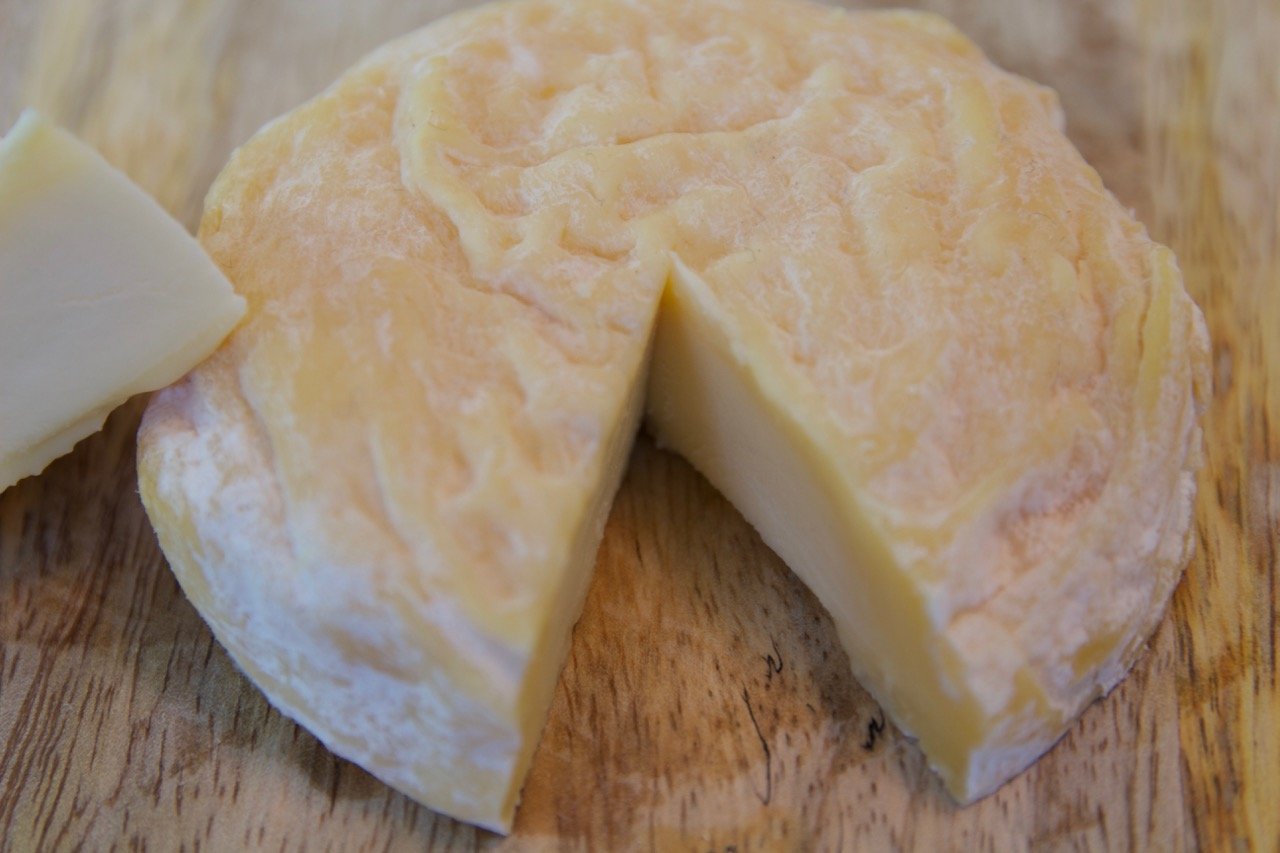I’ve probably told you this before; from my years at the University of Manchester I remember English cheese as rather dull, best used for cheese toasts. But for that purpose they worked very well, and I had a lot of it during my student years. These days, English cheese is a hot topic. A lot’s going on and it is exciting. By and large this is driven by the small producers, farmstead and artisan dairies. Not at the cost of the old and famous cheese that we all know so well, but in addition to. That increases diversity, which is much needed. There are limits for how long you can lean on old tastes before it all collapses. Just look what happened to the Empire.

So this post is about some of this new wine. From a dive into the cheese counter of Neal’s Yard Dairy during Cheese 2017 in Bra last September. I start out with a couple of raw goat milk cheeses.
Innes log
A farmstead cheese made by Joe Bennet at his farm and together with Aimee Lawn. A lactic cheese, typical chèvre style one could say with a rind of Geotrichum and vegetable ash. No added starters, only what naturally surrounds the milk and subsequently the cheese setting off any processes needed for cheese to happen. A dash of rennet is added, though. And what a wonderful cheese it becomes. Innes log is made in Staffordshire and if you’re not quite up to standards about where all the English “shires” are situated; Staffordshire streches from just north of Birmingham and up into the Peak district. The cheese is however not long lived there as it is forwarded to London only a few days old, and matured in the cellars of Neal’s Yard Dairy. As a consequence this is a cheese you can only get through Neal’s Yard.
The shape’s in the name, log, same as St. Maure de Touraine without the straw in the middle.
Fine and round taste with a silky texture. It might happen the rind turns a little bit bloomy, which can give the cheese some peppery tones. That adds to the excitement.
Cardo
Still a raw goat milk cheese, farmstead and from milk from their own herd. But this one has a washed rind giving it more power. From Somerset this one, just proving there’s coming more out of Somerset than Cheddar. I know all too well there are other varieties as well coming from Somerset, just to have said it! Semi-hard or semi-soft texture with a center that sometimes can be slightly crumbly. I know many of you cut off the rind, rather than eat it, and that’s OK, but I still recommend you have a taste. The rind has a rich taste, a bit firm so you have to chew it. Al dente the Italians would say. As more often than not, a woman behind this cheese, Mary Holbrooke makes Cardo at her farm. This is not the only goat milk cheese she is making, and they are all inspired by varieties from continental Europe. What’s so special with this one is that it is made with vegetal rennet, cardoon, which is more common in Spain and especially Portugal. A lot of Portuguese ewe milk cheese is made with the same type of rennet. It was Sephardic Jews that first made cheese using cardoon. That was back around 1500 and they lived in the area by the border between Portugal and Spain. That’s one theory, at least.
The cheese has the form of a disc.

St James
We started off in the West Midlands, headed south west towards Bristol Bay and have now turned round to travel north; to Cumbria. Almost all the way to beautiful Lake District, but only almost. The farm and the dairy lies a short distance inland from the coast. A washed rind cheese made from raw ewe’s milk. A bit sticky rind at times as it varies through the year. Lacaune sheep, same race as provides the milk for the famous blue, Roquefort. My cheese had no sticky rind at all, but resembled more a Reblochon. Apart from the milk, that is. But this variation is part of the fun and what’s so charming with farmstead cheese. Made by Nicola Robinson and Martin Gott at Holker Farm Dairy using the milk from about a hundred ewes. And just in case you’re heading for London in the near future and want to taste it, it’s too late for this season. It is family time in the sheep barn, so you will have to wait till March/April next year before it’s back on the market.
St. Cera
St. Cera is a raw, soft cow’s milk cheese. Quite smallish and comes in a wooden box. From Suffolk, somewhat south of Norwich. I would say this is St. Marcellin style with elements of Langres as well. A washed rind with some Geotrichum. Acidification is in focus with this cheese as with most lactic cheeses. Some rennet is added just before the curd solidifies. The texture is soft, but quite compact. In the mouth it melts nicely, though. Since this is a farmstead cheese it might have some taste of barn, nothing dominant, and usually varies with season. Those cheeses with some geotrichum on the rind may bring some bitter tones, but nothing to worry about. This is a fine and prominent cheese.

To drink
So, what to have with these ones? Quite different cheeses, but at least three of them are unified by the washed rind. That’s something. A semi-dry Vouvray or a German Kabinett. With the Innes log, I would prefer a Sancerre or Pouilly Fumé if you don’t prefer some English bubbles like Nyetimber. I think that would work just nicely.
Lovely post. Looking forward to visiting Neals Yard and having a taste education.
Thanks a lot. Enjoy Neal’s Yard.